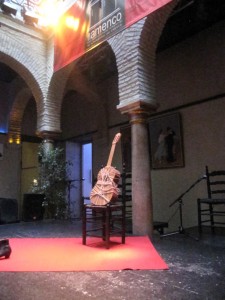Thinking about Spain, most people imagine about bullfights and flamenco dances and I think it is fair to say that those are the two most typical images of Spain. Unfortunately the bullfight season is over and I will not be able to report about my experience of watching a bullfight because I never went to one. I did not know that the season ended so early and I thought I would be terrified to see people torturing and killing four, sometimes six bulls a day. However, I had many chances to watch and learn about flamenco, another treasure of the Spanish culture.
I had always imagined that flamenco is a kind of sexual dance that uses a lot of body movement, but I was wrong. My impression after watching the first flamenco show was that flamenco is more of toe, heel clicking, clapping and expressing emotions rather than dancing. Flamenco dances consist of four elements: singing, guitar playing, dancing and handclapping. The clapping element in a flamenco show is so important that there are people in Spain whose occupation is “palmera”, or handclapper. Meters and time signature in flamenco are complicated and often played with different types of 12-beat rhythms. Guitar is an important part of flamenco but sometimes the dancers and clappers can make music themselves.
Anyone who has seen a flamenco dance can easily tell that the emotions expressed are really strong, from the singer’s voice and tragic tone, the loud music to the speedy rhythms. I had seen an art performance that the artist was using so much strength and sweating so much. The lyrics in flamenco are also deep and intense. Many of the songs are said to be dark and gloomy. Many flamenco songs are about violence, love and betrayal and many reflect the feelings of people in Andalusia, Spain when they were conquered by the Moorish. Sometimes the singing is gentle, slow and sometimes loud, speedy and hasty but the emotions always clearly expressed. The first time I watched a flamenco show, I was amazed at how diverse the dance is. Apparently, if the dance is the expression of emotions, it is not simply slow or fast, just as human beings do not just feel either sad or happy.
For one of my classes during the Intensive Grammar session, we watched a documentary about flamenco and also paid a visit to the Flamenco Museum of Sevilla – the first and only flamenco museum in the world. The museum has three stories exhibition and video clips about different types of flamenco dances as well as flamenco costumes, shoes and instruments. Guitar is the most commonly used instrument but not the only one. Flamenco may also include cello, flutes or saxophones. Flamenco dresses originate from Andalusian women who followed traders to livestock fairs and the dresses are often colorful and accentuate the women’s bodies. The dresses generally have the shape of a guitar, but dresses from different time in the past had different the designs, lace and satin ribbons. A famous flamenco dancer once said that the dress was like an instrument that makes the dancers different from one another.




